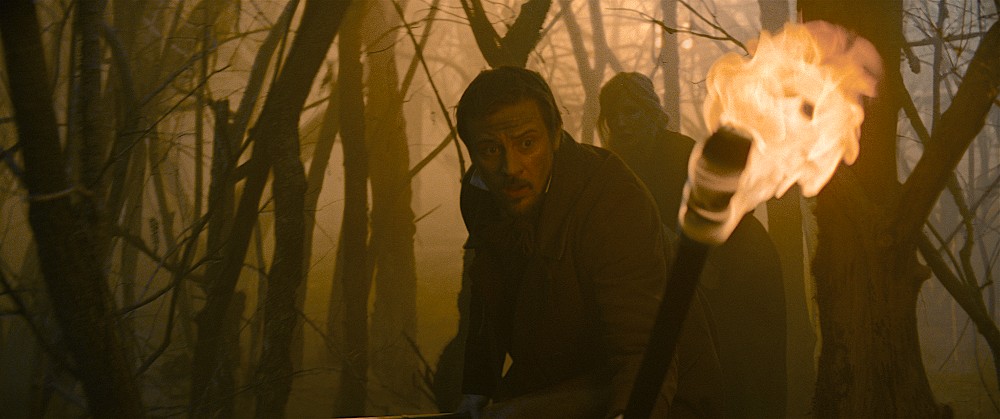
Like many filmmakers, British director Sean Ellis began his career with short films, though that was after many years spent working as a photographer. His 2004 Oscar nomination for his short Cashback helped pave the way for his transition into features, beginning with a feature version of Cashback in 2006.
Both of Ellis’ next two movies, The Broken and Metro Manila, debuted at the Sundance Film Festival, but neither received a U.S. theatrical release. That finally changes with Ellis’ latest, The Cursed, which premiered at Sundance in 2021 under the title Eight for Silver and is getting a fairly wide release this coming Friday.
A gothic period thriller set in 19th century France, the film stars Boyd Holbrook (Logan) as John McBride, a pathologist who has arrived at a small village that has been plagued by the disappearances of several children and others who appear to have been brutally savaged by some sort of wild beast. These occurrences are believed to have begun shortly after an altercation between the Lord of the Manor, Seamus (Alistair Petrie), and a band of gypsies who were driven off his property in brutal fashion.
The Cursed is the kind of indie horror film we haven’t really seen in quite a while — a period werewolf movie. It also looks pretty amazing due to the cinematography from Ellis (who shoots all of his own films) and his talented below-the-line collaborators, most of whom are French.
Below the Line had a chance to speak with Ellis when The Cursed premiered virtually at Sundance last year, at a time when movie theaters in New York and L.A. were still closed as well. Now that the movie can finally be seen in North American theaters, we can share our conversation with you below.
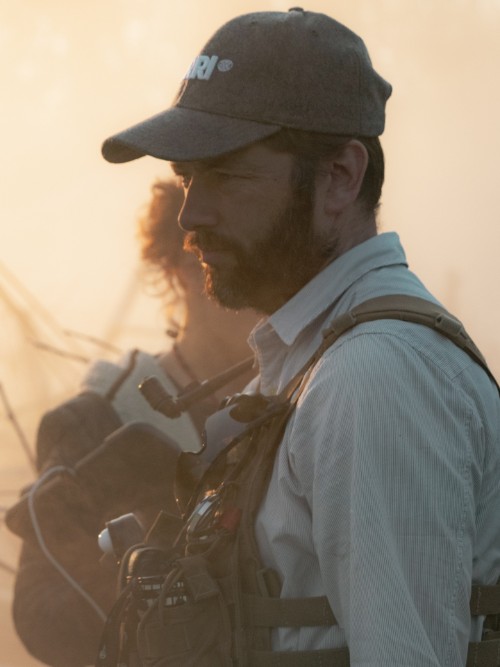
Below the Line: I was surprised to realize it’s been five years since Anthropoid. Was The Cursed something you’d been wanting to do and prepping since then, or did you develop some other projects in those years?
Sean Ellis: It wasn’t, actually. I mean, straight after Anthropoid, I was working with the same producers on another film, and I think it took us about a year to find what we were doing, and then we worked a year on another film, which didn’t actually happen in the end. Right there, you’ve got two years that sort of disappear.
On the back of that, they were like, ‘Well, what else is there? What are you thinking about?’ I told them I’d been thinking about this horror film that surrounded a village in the middle of the countryside. And they were like, ‘Well, that sounds nice. What is it?’ I said it was sort of a ‘werewolfy type thing,’ and they were like, ‘Werewolf? Do you have anything written down?’ It kind of went quite quickly, and I wrote the first draft in like three or four months. It wasn’t complete as the script that finally ended up on the screen, but [Producers] Pete [Shilaimon] and Mickey [Liddell] were like, ‘Why don’t we do this…?’
I think, at the time, it was September 2018. We obviously wanted to shoot in the winter, because I felt that was a really important part of the style and the approach of the film. They said, ‘Well, that means we need to get going right now. We need to be in prep, so we’d be shooting [by] February 2019. But why don’t we do this? Why don’t we shoot for say 30-35 days and then hold back from the budget and shoot any extra stuff we need at the end of the year when the winter comes back.’ So I said, ‘Well, that sounds really interesting. Let’s do that. Because also that will give us some time to edit during summer, look at what we’ve got, and then any other things that we feel might be needed, we can expand them, and we can put that into the script for the end-of-the-year shoot.’
That was kind of our approach. I think what happened was, we shot 35 days at the beginning of 2019, and then we edited over the summer, and then we started talking about [it], and everybody was loving what was there, and they were loving the idea of the film, and there was then talk about making it bigger. It became obvious at that point that it wasn’t about just doing more reshoots. It was about, ‘Let’s shuffle some of the ideas around, let’s change the ending, and what if we did this? And then what if we did that?’
We started to really chat quite in-depth about what we had and what we felt it needed, and I then wrote for a couple of months, extra pages, and Pete and Mickey came back to France at the end of the year. At the beginning of 2020, we basically walked back on set, shooting new pages and new sequences, which included the Battle of the Somme sequence and a lot of the last sequence in the church, the chase through the forest. All that stuff was sort of late addition add-on to what we felt the film needed.
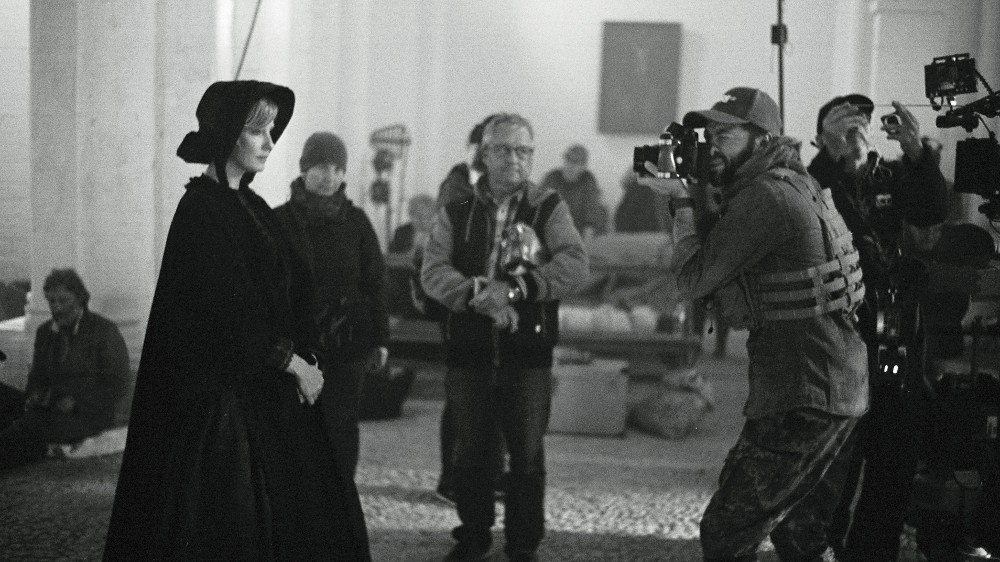
BTL: How did you end up setting the story in France, shooting in France, and also working with a lot of French department heads?
Ellis: Apart from the cast, everybody else is French. There was myself and Pete, the producer, was obviously not French, and the cast were mainly English, apart from Boyd, who is American, and then everybody else that was on the film was French. It worked really well, actually, I have to say. I had such an excellent crew that worked very, very hard. We actually even had two crews, because the first crew that I had in 2019… all of that lot — because they’re so good — they all got the call to go on Ridley Scott‘s movie [The Last Duel] in the beginning of 2020, so I lost them all to Ridley’s movie. I had to re-crew up for the second part. Generally, a lot of the people that came on the second part were friendly with their counterparts on the first part. The gaffer was recommending his friend to do this job, because, ‘If I can’t do a job, I always put my friend up for it, and vice versa.’ It was the same with the grip, and it was kind of funny, because when we all met in Paris, they all know each other really, really well, and all of them got to work on the film, just in two different parts.
BTL: I was wondering about that, since I did notice you had two production designers, which isn’t really that uncommon, as well as two editors. When did you finish the actual shooting part of the movie?
Ellis: About two weeks ago. [Note: A quick reminder that this interview took place in Jan. 2021.] I was actually still filming one of the exteriors three days before we delivered it to Sundance.
BTL: I’ve often heard stories about people delivering their films to Sundance “wet,” maybe having just finished the sound mix or something, but that’s… wow.
Ellis: I remember we didn’t have an exterior of the church, so me and a camera assistant grabbed the camera, and we went to the church. We lit all the interior with lights, and waited for it to get dark, and we surrounded the church with a smoke machine/tube, and then we shot it. He literally packed all the camera stuff and put it back in the van. I took the film with me to the train station and went straight to Paris, and I gave it to the lab. The next day it was processed, and that afternoon, we’d slotted it into the film, and it had been graded, and then the following day, it was checked, and then at the end of that day, the file was sent to Sundance. Yeah, it was that close. [laughs]
BTL: When I’ve spoken to filmmakers recently, I’ve learned so much of what was done remotely during the pandemic, which would have been unheard of, like mixing the sound for a movie remotely, or coloring. How did the pandemic affect your production?
Ellis: The pandemic didn’t really affect us, to be honest with you. We had finished filming when the lockdown went on. It only affected me because I actually got COVID and was ill with it for a couple of weeks, but then coming out the other side of it, we were always gonna edit part two remotely, because my editor was in New York and couldn’t travel. It’s the same editor I’ve used on Anthropoid, it’s the same editor I’ve used on Metro Manila. Richard [Mettler], we have a shorthand, so we weren’t worried about being in the same room. We just edited remotely. It was the fact that there was a lockdown going on as well, and he couldn’t move from New York, and I couldn’t move from here, but it didn’t really affect us, because we were actually supposed to be editing for four months remotely anyway. Even if the pandemic wasn’t going to go on, he’d still be in his apartment in New York editing, and I’d still be in my house in France editing with him on Skype. So yeah, it didn’t really affect us. And then, things kind of opened up again for me to go back to Paris and do the sound and the grading, so that didn’t really affect us to be honest with you. Apart from the fact that Sundance is virtual, which is a shame, but you duck and roll with the punches.
BTL: I want to go back and talk about developing the look of the movie with the art department, costumes, etc. The movie made me think of Brotherhood of the Wolf, which is maybe 20 years old now, but I think people who really love horror do know it pretty well, and this is also a gothic movie involving a werewolf or wereperson, or whatever you want to call those creatures…
Ellis: I think, originally, I was very wary about calling it a “werewolf,” but to be honest with you, I think that probably came from my own insecurities of doing something clichéd, but I think where we’re at now, I quite like the idea that it’s associating a werewolf with something that you haven’t actually seen before. I think the design element of our wolf hasn’t been seen before, and that’s very exciting to present. And again, it came out of a very, very, very long process of research and development, and it started with Mark Coulier, who did some initial designs, then, Jean-Christophe Spadaccini took those designs and sculptured the beast and made it a practical thing on set that we could move around. Once we looked at it on camera, we had certain issues with it that we felt [weren’t] working, and so, I then gave the footage to a concept artist I know, and he basically helped me bring it to sort of roughly where it is now.
That concept design was then handed over to CG, and they started to work on a 3D asset that could move, and they could place it. I think, ultimately, having the original beast on set was always quite handy, because it gave the actors some eyeline, and secondly, you could see our light was reacting to it, and the CGI boys then add a reference point to start with, which was great. It was a lot of work, and definitely a labor of love, but I think everybody was seeing what I was trying to do with it, and they were getting very excited. It was like people were ducking and rolling their eyes, which sometimes you feel people get a bit like that when you’re trying to get something to a certain point.
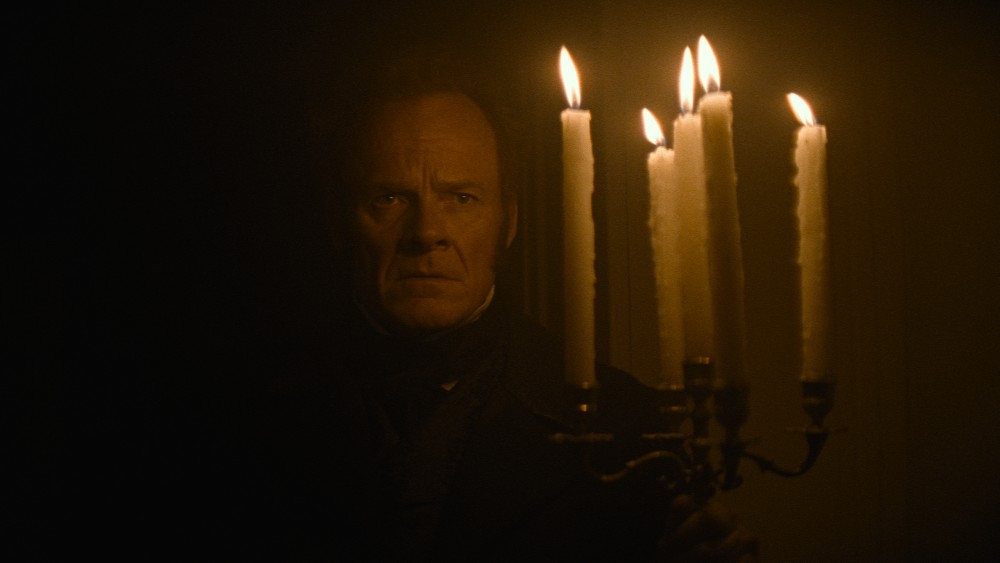
BTL: What was on set for the actors to see? Was it a statue or model of some kind?
Ellis: Yeah, it was a full animatronic, moveable… It could run really fast, because it was designed so that the actor got into the suit, but it was like a wheelbarrow, so he was laying flat with his hands on the floor, but his body was like on a plank, and then the whole system was on wheels and the back legs of the wolf were attached to the wheels. So if the wheels went round, the legs moved. It took two guys to lift it and run with it, and they just ran with it. When they ran with it, he was able to just do the acting with his front legs, and then there was another guy that would run with it, and he had all the controls are the face and the mouth and the eyes, and he would move it all. So yeah, it was a full-on animatronic beast, but I mean, again, it looked slightly different to what we ended up with. We could tweak it and change it in post, but it was very interesting to see and have something like that on set.
Back to production design and costumes, it was just, again, a lot of research and a lot of development and a lot of testing. Even down to the wallpapers that were on the walls in the manor. All of that was tested and photographed on film and processed with different stocks to see how it would react with different lighting, with candlelight, with daylight. It was a very laborious testing process of probably about 12 weeks. I think we tested clothing, film stock, production design — there was a lot of that happening. Luckily, the Manor House was not far from my house. We literally took over that place for six months, and it just became our studio.
BTL: You’re somewhat of a rare breed of filmmaker, since you not only write, direct, and produce, but you’re also your own cinematographer. I think Steven Soderbergh is one of the few other filmmakers who still does that. Has that been the case for all of your movies, and if so, why is that important for you to do yourself?
Ellis: I come from a photographic background. I was a photographer before I was a filmmaker. I know composition and film stock exposure and lenses, like any other cinematographer, because that was my background from a very, very young age. I was a working photographer by the age of 18. That’s what I was doing. I was trained as a printer for a wedding photographer at first. From 15, I was inside the darkroom, printing, and then by 18, I was out taking my own pictures. And then by 19, I was actually self-employed and making a living from being a photographer. I think people sometimes think that I’m a director that thinks he knows about photography. In actual fact, it’s the other way around. I’m a photographer that sort of moved into directing. It’s physically demanding, because obviously, you’re carrying a camera all day, but a lot of that comes very naturally to me, working with cameras and setting shots up. That’s kind of how my brain is geared up to work.
I’m very dyslexic, so writing is probably the thing I have the most difficulty with. I have the imagination to come up with an idea and a story, but the thing that takes the time is actually trying to write that story down into some coherent thing. What I’m actually doing is translating the images in my mind into script form, and then everybody reads the script, and then I transform the script form back into the images I originally had, so that’s generally the way I will work.
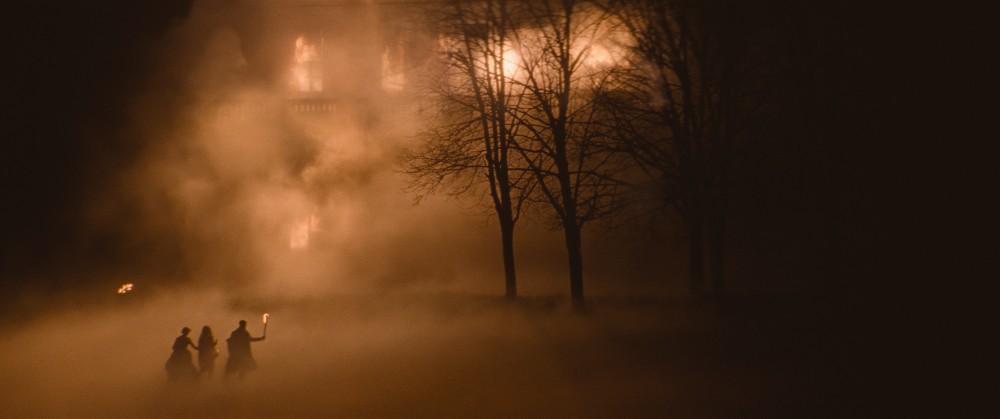
BTL: I do want to ask you about one particular scene earlier in the movie. The raid on the gypsy camp is quite an amazing set piece, which you do in a single one-shot but with a camera some distance away that captures it all from afar. There’s very little way to cheat that in editing, so how do you stage that scene so that you can shoot it that way?
Ellis: It took one day to film, and we had two cameras on camera cranes, and the stunt team — because everybody in there is mainly stunt people — they’d rehearsed it for about a week or 10 days. Obviously, [there were] a lot of meetings with the pyrotechnic people and how it was going to happen, and the production design. I remember I just wanted to do it in a wide [shot] with no cuts, and the reason being, also… because, again, it’s a film that sort of demands to be seen on the big screen, and I think when you have set pieces like that, I mean, hopefully, looking at that on your computer, you go, ‘I wish I could see this in [a] cinema because that would look amazing.’ So that was kind of designed like that in a weird way, because I wanted it to be looked at as a cinematic film.
At the same time, I wanted it to be a little daring and a bit surprising, because everybody would say to me, ‘Are you sure you don’t want to cut in and do some stuff in there?”‘ And I was like, ‘No,’ because that’s what everybody would expect you to do. Nobody’s ever done something on this scale in a wide shot, so that was kind of the approach, [to] try and do something that was exciting and that I hadn’t seen before, that I felt was interesting.
Everybody was like, ‘Wow, okay, so you’re gonna do all that, and it’s gonna be one take, and you’re not going to do any…’ There was a lot of discussion about, ‘You sure you don’t want to hide a camera down there somewhere and get some coverage? Or at least a cut point?’ But no, I mean, it’s one of those things. I think if you had that footage, there’d be pressure for you to maybe make a cut. I think because we didn’t, there was only one way of presenting it, and it’s the way that’s in the film. It’s great when you do stuff like that. It’s nerve-wracking at the same time. I mean, there are a few sleepless nights, knowing that the film we just shot is now going to the lab in Paris, and it’s the only shot we’ve got of that massive set piece that we just did. And a few sleepless nights, while you’re waiting for the neg report to come back from the lab.
BTL: That scene really blew me away. I was also like, ‘Is he really going to do this completely in a long shot?’ and you did! I personally can’t wait to see this with an audience, and I hope you get to see it in a theater, too, since this is the kind of movie where reactions from others will greatly add to the experience.
Ellis: I’d love to be in a full theater and see it play with people. Again, that’s one of the lovely things about this genre. It’s still one of the ones that people go to the cinema [for], to get scared. Everybody’s going there for the same reason, so there’s a want for it to be good, and there’s a want for it to be scary. I think that’s probably why the genre gets bashed quite often, because if you don’t deliver something that’s really good, and what people are expecting, they get quite angry about it. They want to be scared. They want to go there and see something fresh and new, and they want to go to work the next day or just email their friends and say, ‘Oh my God, have you seen this thing? It’s incredible.’ I think there’s a want for it to be good and for you to deliver, so there’s also that added pressure that that’s what you have to do.
BTL: Horror is now perceived differently than it was in the ’80s and ’90s when genre filmmakers were rarely considered to be among the town’s top directors, but now horror is yielding some of the best and most interesting movies out there, and genre filmmakers like James Wan and Jordan Peele are becoming brands unto themselves. It’s been a remarkable turnaround, so what do you make of the shift in attitudes towards horror?
Ellis: The horror genre has become … they call it elevated horror now, don’t they? It’s not just about a slasher movie and gore. It’s about a cerebral story that really plays on your fears. There’s been some fantastic films that have come out in the last five years that have been regarded as that kind of elevated horror genre. I definitely felt that if I was gonna go there and do something like this, that was the area I wanted to play with.
The Cursed opens in theaters nationwide on Friday, Feb. 18





